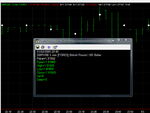Hi Everybody,
I have started using TradeStation, written some strategies and here are some problems I have encountered:
1. How can I load more 5-min data, e.g. 5 years for better testing/optimization?
2. MarketPosition is always 0 when I do history testing. Is there any way to know which position is currently open?
3. How to draw some lines on a chart from strategy (as opposed to indicator)? When I add Plot1 it says this word is not allowed in a strategy.
Thanks in advance.
I have started using TradeStation, written some strategies and here are some problems I have encountered:
1. How can I load more 5-min data, e.g. 5 years for better testing/optimization?
2. MarketPosition is always 0 when I do history testing. Is there any way to know which position is currently open?
3. How to draw some lines on a chart from strategy (as opposed to indicator)? When I add Plot1 it says this word is not allowed in a strategy.
Thanks in advance.
Last edited:



